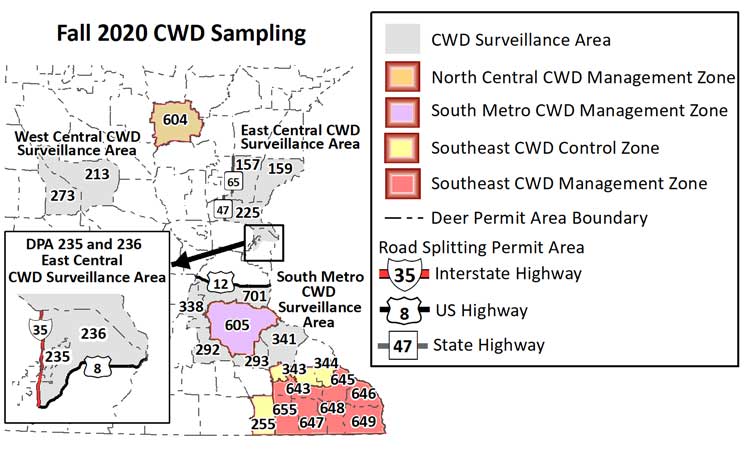Minnesota’s firearms deer season begins half an hour before sunrise on Saturday, November 7, and the Minnesota Department of Natural Resources expects nearly half a million hunters to participate. To assist with your coverage of the deer season, here are materials about deer hunting in Minnesota.
Firearms deer season is one of several seasons for deer hunters. Archery deer season opened September 19 and lasts through Thursday, December 31. Muzzleloader deer season is from Saturday, November 28, through Sunday, December 13.
Hunters are advised to make a deer hunting plan this year – not only to buy their licenses, but also to figure out where to hunt, whether they will be providing a sample for chronic wasting disease testing, and how they will process their deer.
Hunters who are traveling should do the following to help minimize the spread of COVID-19:
- Travel as directly to your destination as possible, and minimize stops along the way.
- Attempt to bring all needed supplies with you.
- If you do need to stop for gas or supplies, wear a cloth face covering.
- Wash your hands or use hand sanitizer after touching common surfaces (gas pumps, door handles, shared bathrooms, etc.).
- Do not travel if sick.
The DNR’s outdoor recreation guidelines are available on the COVID-19 webpage.
Harvest Opportunities
This season, hunters in general will have more opportunities to harvest deer because deer populations have increased in much of the state. Opportunities in southeastern Minnesota have also been increased as part of the DNR’s response to chronic wasting disease.
Hunters in north-central, northwestern and south-metro areas of Minnesota should double-check deer permit area boundaries. Some boundaries have changed due to public input during the deer population goal-setting process or in response to chronic wasting disease spread.
Safety The First Priority
Hunters should follow the three tenets of safe firearms handling: Treat every firearm as if it is loaded by keeping your finger off the trigger; always control the muzzle of the firearm; and be sure of the target and what is beyond it. Tree stand accidents are the leading cause of injury to hunters, so it’s always important to wear a safety harness and follow other safety guidelines when using a stand.
CWD Management Continues
The DNR continues its aggressive management of CWD by reducing deer densities, implementing feeding and attractant bans to reduce contact between deer, and restricting carcass movement.
The DNR created additional surveillance areas because CWD was detected in both wild and captive deer in new areas last year. As part of the DNR’s COVID-19 response, CWD testing will be voluntary for all disease zones and surveillance areas. Hunters who harvest a deer in a disease zone are strongly encouraged to submit a sample. More details are available on the CWD webpage.
The DNR is, as in previous years, enforcing carcass movement restrictions in disease management and control zones to limit the spread of disease.
On July 1, deer feeding and attractant bans expanded to include the south metro area. Due to the spread of CWD and the DNR’s CWD management strategy, the antler point restrictions in southeastern Minnesota are not in place this year and cross-tagging, also known as party hunting, will be allowed in southeastern Minnesota for antlered bucks.
How To Get Hunting Questions Answered
Hunters can contact the DNR Information Center to get their deer hunting questions answered. Information consultants are available by phone at 888-646-6367 or email at info.dnr@state.mn.us.
Due to the volume of email the DNR receives, people are strongly encouraged to call for immediate information, or check the DNR deer hunting page for information.
To report a violation in progress, call the Turn In Poachers (TIP) Line at 800-652-9093. Information Center business hours are 8 a.m. to 6 p.m. Monday through Friday and Saturday 8 a.m. to 4:30 p.m.
On the DNR website, hunters can find deer hunting information on the DNR deer hunting page, and they can join in on social media using #DeerCampMN.
Minnesota Deer And Hunting Facts
- Adult female white-tailed deer weigh about 145 pounds, and males weigh about 170 pounds.
- A whitetail’s home range is about 1 square mile.
- The biggest white-tailed deer recorded in Minnesota was a 500-pound buck.
- Last year, 31% of Minnesota-licensed firearm hunters successfully harvested a deer.
- Seventy percent of Minnesota’s firearms deer harvest typically occurs during the first three or four days of the season.
- The average hunter spends five days afield during Minnesota’s firearms deer season.















